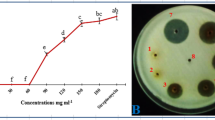Abstract
The present investigation aimed to test the in vitro toxicity of Brassica volatiles against soil-borne plant pathogens (Rhizoctonia solani Kuhn, Sclerotium rolfsii Sacc., Fusarium oxysporum f.sp. ciceris (Padwick) Matuo & K. Sato and Sclerotinia sclerotiorum (Lib.) de Bary) and biocontrol fungus Trichoderma harzianum Rifai. Moreover, the response of T. harzianum to toxic volatiles was also studied in terms of glucanase and chitinase gene expression. A strong fungistatic effect of B. alba treatment was recorded against all the test pathogens. Noticeably, S. sclerotiorum manifested least sensitivity among all the tested pathogens. All T. harzianum isolates were less sensitive as compared to the assayed pathogens. Based on the in vitro study involving 6 T. harzianum isolates, T55 and Th-R showed least, while T39 showed highest sensitivity to the volatiles. Interestingly, the patterns relating to the effect of volatiles on inoculum density of T. harzianum isolates were similar to their effect on fungus growth in vitro. More importantly, expression of chitinase and glucanase genes in different Trichoderma isolates was up-regulated, which could improve the biocontrol activity of T. harzianum. Therefore, here the authors envisage that combining biocontrol and biofumigation has the potential to provide sustainable and cost-effective strategies to manage soil-borne plant pathogens.



Similar content being viewed by others
References
Methyl Bromide: Quarantine and Preshipment Uses. http://ozone.unep.org/Publications/UNEP-Ozone-Secretariat-MP-Brochure.pdf
Redovnikovic IR, Glivetic T, Delonga K, Vorkapic-furac J (2008) Glucosinolates and their potential role in plant. Periodicum Biologorum 11(4):297–309
Bones AM, Rossiter JT (1996) The myrosinase-glucosinolate system, its organisation and biochemistry. Physiol Plant 97:194–208
Vig AP, Rampal G, Thind TS, Arora S (2009) Bio-protective effects of glucosinolates – A review. LWT - Food Science and Technology 42:1561–1572
Matthiessen JN, Kirkegaard JA (2006) Biofumigation and Enhanced Biodegradation: opportunity and Challenge in Soil borne Pest and Disease Management. Crit Rev Plant Sci 25:235–265. doi:10.1080/07352680600611543
Sarwar M, Kirkegaard JA,Wong PT Desmarchelier JM (1998) Biofumigation potential of brassicas. iii in vitro toxicity of isothiocyanates to soil borne fungal pathogens 201(1):103-112. doi:10.1023/A:1004381129991
Griffiths HM, Gies D, Zitter TA (2011) Brassicas as Biofumigants for Controlling Soilborne Organisms in Potato Production for Upstate New York and Northern Pennsylvania http://vegetablemdonline.ppath.cornell.edu/NewsArticles/Brassicas%20Factsheet%20Final%20August%202011.pdf
Lu P, Gilardi G, Gullino ML, Garibaldi A (2010) Biofumigation with Brassica plants and its effect on the inoculum potential of Fusarium yellows of Brassica crops. Eur J Plant Pathol 126(3):387–402
Harman GE, Howell CR, Viterbo A, Chet I, Lorito M (2004) Trichoderma species-Opportunistic, avirulent plant symbionts. Nat Rev Microbiol 2:43–56
Mukherjee PK, Horwitz BA, Herrera-Estrella A, Schmoll M, Kenerley CM (2013) Trichoderma Research in the Genome Era. Annu Rev Phytopathol 51:105–129. doi:10.1146/annurev-phyto-082712-102353
Galletti S, Sala E, Leoni 0, Burzi PL, Cerato C (2008) Trichoderma spp. tolerance to Brassica carinata seed meal for a combined use in biofumigation. Biological Control 45(3):19-327. doi: 10.1016/j.biocontrol.2008.01.014
Sanchi S, Odorizzi S, Lazzeri L, Marciano P (2005) Effect of Brassica carinata seed meal treatment on the Trichoderma harzianum T39-Sclerotinia species interaction. Acta Hortic 698:287–292. doi:10.17660/ActaHortic.2005.698.38
Smith BJ, Kirkegaard JA (2002) In vitro inhibition of soil microorganisms by 2-phenylethyl isothiocyanate. Plant Pathol 51:585–593
Gallettia S, Fornasierb F, Cianchettaa S, Lazzeria L (2015) Soil incorporation of Brassica materials and seed treatment with Trichoderma harzianum: effects on melon growth and soil microbial activity. Ind Crops Prod 75:73–78. doi:10.1016/j.indcrop.2015.04.030
Krassilnikov NA (1950) Actinomycetes-antagonists and antibiotic substances. S.R., Mascow, Leningrad, Academy of Sciences, U.S (in Russian)
Gil SV, Pastor S, March GJ (2009) Quantitative isolation of biocontrol agents Trichoderma spp., Gliocladium spp. and actinomycetes from soil with culture media. Microbiol Res 164(2):196–205. doi:10.1016/j.micres.2006.11.022
Chakraborty BN, Chakraborty U, Saha A, Dey P, Sunar K (2010) Molecular Characterization of Trichoderma viride and Trichoderma harzianum Isolated from Soils of North Bengal Based on rDNA Markers and Analysis of Their PCR-RAPD Profiles. Global J Biotechnol Biochem 5(1):55–61
Prasad P, Kumar J (2012) An RNA isolation protocol for recovery of high quality functional RNA from fungi and plants. Curr Sci 102(9):1257–1260
Clarkson J, Michel V, Neilson R (2015) Mini-paper - Biofumigation for the control of soil-borne diseases. http://ec.europa.eu/eip/agriculture/sites/agri-eip/files/9_eip_sbd_mp_biofumigation_final_0.pdf
Manici LM, Lazzeri L, Palmieri S (1997) In vitro fungitoxic activity of some glucosinolates and their enzyme-derived products toward plant pathogenic fungi. J Agric Food Chem 47(5):2768–2773. doi:10.1021/jf9608635
Neubauer C, Heitmann B, Müller C (2014) Biofumigation potential of Brassicaceae cultivars to Verticillium dahliae. Eur J Plant Pathol 140(2):341–352. doi:10.1007/s10658-014-0467-9
Rahmanpoura S, Backhousea D, Nonhebe HM (2009) Induced tolerance of Sclerotinia sclerotiorum to isothiocyanates and toxic volatiles from Brassica species. Plant Pathol 58:479–486. doi:10.1111/j.1365-3059.2008.02015.x
Kirkegaard JA, Simpfendorfer S, Holland J et al (2004) Effect of previous crops on crown rot and yield of durum and bread wheat in northern NSW. Aust J Agric Res 55(3):321–334. doi:10.1071/AR03178
Haran S, Schickler H, Chet I (1996) Molecular mechanisms of lytic enzymes involved in the biocontrol activity of Trichoderma harzianum. Microbiology 142:2321–2331
Ait-Lahsen H, Soler A, Rey M, de La Cruz J, Monte E, Llobell A (2001) An antifungal exo-alpha-1,3-glucanase (AGNI 13.1) from the biocontrol fungus Trichoderma harzianum. Applied. Environ Microbiol 67(12):5833–5839
Ting ASY, Chai JY (2015) Chitinase and β-1,3-glucanase activities of Trichoderma harzianum in response towards pathogenic and non-pathogenic isolates: early indications of compatibility in consortium. Biocatalysis and Agricultural Biotechnology 4(1):110–113. doi:10.1016/j.bcab.2014.10.003
Acknowledgements
The present study was undertaken as a part of the project entitled “Promoting IPM through a Common Minimum Programme in vegetable cultivation in Uttarakhand hills”, funded by Government of Uttarakhand (Letter No. 1757/Lekha-1/Ra-Kri. Yo./2008-09 dt. 10.07.2008). The authors are thankful to Government of Uttarakhand; Dean, College of Agriculture and Director Experiment Station, G.B.P.U.A.T., Pantnagar for their valuable assistance during this study.
Author information
Authors and Affiliations
Corresponding author
Ethics declarations
Conflict of interest
The authors declare that there are no conflicts of interest regarding this manuscripts.
Rights and permissions
About this article
Cite this article
Prasad, P., Kumar, J. & Pandey, S. Investigating Disease Controlling Ability of Brassica Volatiles and Their Compatibility with Trichoderma harzianum . Proc. Natl. Acad. Sci., India, Sect. B Biol. Sci. 88, 887–896 (2018). https://doi.org/10.1007/s40011-016-0829-5
Received:
Revised:
Accepted:
Published:
Issue Date:
DOI: https://doi.org/10.1007/s40011-016-0829-5




